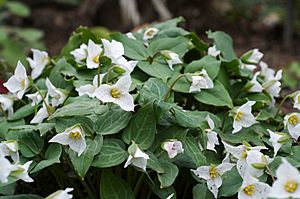Pseudotrillium facts for kids
Quick facts for kids Brook wakerobin |
|
|---|---|
 |
|
| Scientific classification | |
| Genus: |
Pseudotrillium
|
| Species: |
rivale
|
| Synonyms | |
|
Trillium rivale S.Watson |
|
The brook wakerobin (scientific name: Pseudotrillium rivale) is a beautiful flowering plant. It is the only type of plant in its group, called a genus, which is named Pseudotrillium. Scientists decided in 2002 that this plant was unique enough to have its own genus. They looked closely at its shape and used genetic tests to figure this out. Before that, it was thought to be part of the Trillium plant group.
Contents
Where the Brook Wakerobin Lives
The brook wakerobin is a very special plant because it is endemic. This means it grows naturally in only one small area. You can find it in the Siskiyou Mountains of southern Oregon and northern California.
It often grows in unique soils called ultramafic soils, like serpentine. These soils are special because they have a lot of certain minerals. The plant's scientific name, rivale, means "growing by streams." This tells us it likes to live near water.
What the Brook Wakerobin Looks Like
The brook wakerobin is a rhizomatous herbaceous perennial plant. This means it grows from an underground stem called a rhizome. It also means it's a plant that comes back year after year. It can grow up to 20 cm (7.9 in) tall.
The plant has three leaf-like parts called bracts. These bracts are usually shaped like a spear, up to 11 cm (4.3 in) long. They grow on small stems called petioles, which are 1 to 3 cm (0.4 to 1.2 in) long. The bracts are shiny blue-green with silvery lines.
A single flower grows on a stem called a pedicel, which is 2.5 to 11 cm (1.0 to 4.3 in) tall. The flower hangs down and does not have a smell. It has green sepals, which are like small leaves that protect the bud. The petals are white with a pink blush. They can be up to 3 cm (1.2 in) long and 2 cm (0.8 in) wide.
Life Cycle of the Brook Wakerobin
This plant usually flowers from April to June. If it grows in higher places, it might flower a bit earlier, from late March to early May.
After the flowers bloom, the whole plant can get bigger and stronger. Its leaves become very shiny. But by the middle of July, the plant starts to dry up and goes dormant. This means it rests underground until the next growing season.
A Special Plant for Gardens
The brook wakerobin, when it was known as Trillium rivale, received a special award. It got the Royal Horticultural Society's Award of Garden Merit. This award means it's an excellent plant for gardens.
It is a tough plant that can survive cold weather, down to −10 °C (14 °F). However, it needs a protected spot in a garden. It also prefers to grow in partial shade or full shade.

